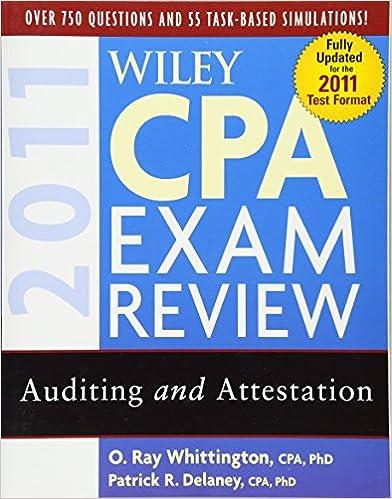Question
CASE OVERVIEWw The CFO at the Rubrics Corporation, a midsize hardware manufacturing firm, had become aware of the ongoing imbalance between the product's budgeted and
CASE OVERVIEWw The CFO at the Rubrics Corporation, a midsize hardware manufacturing firm, had become aware of the ongoing imbalance between the product's budgeted and actual costs. The Rubrics Corporation normally to products using a single direct cost driver, usually direct labor hours or direct labor dollars. This practice sometimes led to inaccuracies, since indirect costs were not incurred equally across products. For example, Rubrics CFO had forecasted S10,000,000 in direct labor costs and $15.000,000 in overhead for a particular project last year, resulting in an overhead rate of 150 per cent. For each dollar of direct labor charged, $1.50 of overhead had been allocated. The shortcoming of this costing method was that overhead costs failed to reflect varying manufacturing intensity between products. Often referred to as smoothing, traditional costing allocates overhead costs evenly per direct labor hours or dollars. Unfortunately, direct costing can result in a discrepancy between the budgeted overhead and the actual overhead used. Often, certain products require more maintenance or floor space. Traditional costing allocates overhead based on direct expenses without compensating for a product's greater or lesser use of overhead costs Activity-based costing (ABC) w BC had enjoyed wide acceptance as a more accurate alternative to traditional costing, especially in manufacturing Instead of budgeting overhead using direct cost drivers, ABC splits overhead into activity cost drivers, leading to a more tangible assignment of cost as first introduced in the United States during the 1970s Since then, A Calculating ABC is more complicated than calculating traditional costing. Once management identi the activity cost drivers, overhead rates are assigned per cost budgeted costs per driver by the anticipated resource requirements for each cost driver For instance. r could be allocated based on the square footage occupied by inventory in producing a given product d service. Say X Company estimates next year's rental costs to be $30,000 for its 15,000-square-foot overhead rates are assigned per cost driver. The rates are estimated by dividing factory. X Company can calculate the rental overhead rate by dividing $30,000 by 18.000 to get 2, Afte tes a calculating the overhead rates f river (rent, depreciation, maintenance, etc), t applied to the individual requirements of each produet. Continuing the previous example, suppose X mpany manufactures two products, Y and Z, requiring 10,000 and 5,000 square feet of factory space respectively. X Company can calculate each product's individual use of factory rent by multiplying 10,000 and 5,000 by 2, resulting in $20,000 for Y and $10,000 for Z s. The ABC The objective of ABC is to align actual consumption with speeific product/service cost proach is normally associated with multiple produets or serviccs using sharcd and often common indircet resources. A benefit of ABC is that products requiring higher concentrations of overhead costs are costs or to price revealed, allowing management to focus attention on opportunities for reducing those more appropriately Activity-based costing allocates overhead to a product based on the actual amount of overh roduet. Whenever common resources are expended in different ways across products, a weight mechanism is required for accurate allocation. ABC can be equally valuable in service industri ead used by that es Financial institutions have diverse products and customers, resulting in cross-product, cross-customer tions. Accordingly, these costs must also be attributed more accurately to products and subsidies. Often, personnel expenses represent the largest single component of non-interest expen customers via activity-based accounting. The ABC methodology is an involved process with many steps, including identifying direct prod computing overhead rate per cost activity, uct costs ctivities, selecting cost-allocation basis (CAB), identifying indirect costs per CAB, calculating overhead costs based upon each product 's use of the various cost activities, and then adding direct expenses and indirect expenses to yield total product costs Despite the complexity, the benefits of ABC can be significant: management can distinguish profitable cost controls can be established to eliminate unnecessary costs, and produets ent should consider whether the cost of identifying overhead cost can be better priced. Ilowever savings from more accurate bu drivers and each product"s individual resou HEL than the research co re DIRECT LABOR, OVERHEAD, AND DIRECT MATERIALS COSTS Total direct labor Total overhead $1.000,000 2,000,000 200% of di Wiagets direct labor Gadgets direct labor Smidgets direct labor Smadgets direct labor Widgets direct material Gadgets direct material $100,000 $300,000 $400,000 $200,000 $100,000 $200,000 $150,000 $250,000 1.000 of each product Smadgets direct material Units built Exhibit 2 OVERHEAD COST DRIVERS Cost allocation basesTotal costs Depreciation Set-up Q Quantity of CAB $300,000 3,000 machine hours $700.0001000 set-up hours $1,000.000 100,000 square feet Exhibit 3 PRODUCT RESOURCE REQUIREMENTS BY COST DRIVER Widgets 00 machine hours900 machine hours Gadgets Smidgets o machine hours l 1200 macaine nourts 100 set-up hours Smadgets 5 0 0 O set-up hours 30.000 square feet 200 set-up hours-11 - 400 set-up hours 20,000 square feet 10,000 square feet -40,000 square feet A) What were two circumstances with traditional and ABC costing would likely yield similar or equal overhead costs?
Step by Step Solution
There are 3 Steps involved in it
Step: 1

Get Instant Access to Expert-Tailored Solutions
See step-by-step solutions with expert insights and AI powered tools for academic success
Step: 2

Step: 3

Ace Your Homework with AI
Get the answers you need in no time with our AI-driven, step-by-step assistance
Get Started


